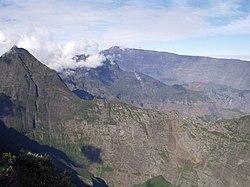Réunion National Park
This article has multiple issues. Please help improve it or discuss these issues on the talk page. (Learn how and when to remove these template messages)
|
| Réunion National Park | |
|---|---|
 | |
| Lua error in Module:Location_map at line 526: Unable to find the specified location map definition: "Module:Location map/data/ReunionLocatie.png" does not exist. | |
| Location | Réunion (France) Western Indian Ocean |
| Nearest city | Saint-Denis |
| Area | 1,054.47 km2 (407.13 sq mi) 173.0 km2 (66.8 sq mi) (core area) 162.0 km2 (62.5 sq mi) (buffer zone) |
| Established | 2007 |
| Governing body | Parcs nationaux de France [1] |
| UNESCO World Heritage Site | |
|---|---|
 View from La Roche Écrite | |
| Criteria | Natural: vii, x |
| Reference | 1317 |
| Inscription | 2010 (34th Session) |
Réunion National Park (French: Parc national de La Réunion) is a national park on the island of Réunion, an overseas department of France located in the western Indian Ocean region. Established on 5 March 2007,[1] the park protects the endemic ecosystems of Les Hauts, Réunion's mountainous interior. The park's core zone and part of its buffer zone were designated a World Heritage site in 2010, under the name "Pitons, cirques and remparts of Reunion Island".
Planning for the park
Proposals to create a regional natural park were first raised beginning in 1992. Three years later, the Réunionnaise Environmental Charter and the Regional Development Plan formally established the principle that a park should be created in Les Hauts. The concepts of sustainable development were central to these proposals, which explicitly intended to combine protection of Réunion's natural and cultural heritage with promotion of economic development.
On 6 November 2000, the Minister of the Environment and Regional Planning Dominique Voynet launched the process to create a national park on Réunion. Subsequently, on 7 February 2001, a working agreement was signed to guide efforts toward establishing the park.[2]
After an intense period of studies, debates, dialogue, and negotiations, the steering committee issued its report on 12 March 2003. The Les Hauts National Park Project outlined ambitions and principles for the creation of a "national park for a new generation". It was shortly before the final public hearing at the end of 2006 that the working name of Les Hauts National Park was dropped in favor of Réunion National Park.
The park officially came into existence on 5 March 2007 through a decree taken after advice by the Council of State,[1] with a formal inauguration on 9 July. In its final form, the new national park incorporated two pre-existing nature reserves:
- Saint-Philippe Mare-Longue Nature Reserve, which had protected the Mare Longue Forest in Saint-Philippe commune since 1981.
- La Roche Écrite Nature Reserve, which protected the habitat of the endangered Réunion cuckooshrike (French: tuit-tuit), an endemic forest bird, on the slopes of the 2,276-meter (7,470 ft) Roche Écrite massif. Established in the 1990s, it straddled the territories of Saint-Denis and La Possession communes.
Park mission

This section needs expansion. You can help by adding to it. (September 2008) |
Réunion National Park's core mission is to safeguard the island's endemic species, in contrast to Guiana Amazonian Park in French Guiana, which was established at the same time, but in order to protect the biodiversity within its boundaries. The number of endemic species on the island is triple that of Hawaiʻi, and four times that of the Galapagos.[3]
Park features and wildlife

This section needs expansion. You can help by adding to it. (September 2008) |
Management

Budget and structure
The park began with a budget of €2 million in its first year. As its activities expand, the budget is slated to progressively increase to €8 million. Park headquarters is at La Plaine-des-Palmistes.
The park is governed by an administrative council composed of 88 members. The administrative council elects 15 from among its members to serve as an executive committee. They are advised by a scientific council composed of 18 members and 5 outside experts. Plans additionally call for the creation of an economic, social, and cultural council.
Management issues
The park administration has supported exploration for geothermal power sources on the Plaine des Sables, against the advice of the scientific council and despite the fact that the park may soon be proposed as a World Heritage Site.
Notes and references
- ^ a b Conseil d'État (6 March 2007). "Decree No. 2007-296 of 5 March 2007 Creating Réunion National Park, consolidated version". Paris. Retrieved 6 April 2008.
- ^ Signatories of the working agreement were Prefect Jean Daubigny; Paul Vergès, President of the Réunion Regional Council; and Jean-Luc Poudroux, President of the Réunion General Council.
- ^ Notter, Jean-Cyrille (2008). "La Réunion au patrimoine mondial de l'Unesco? En bonne voie…" (in French). Télé Mag Réunion.
{{cite news}}: Cite has empty unknown parameter:|coauthors=(help)
External links

